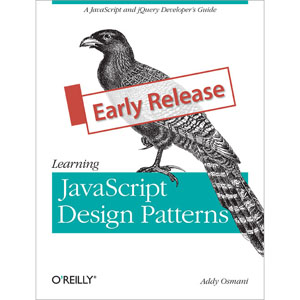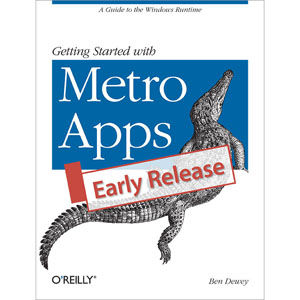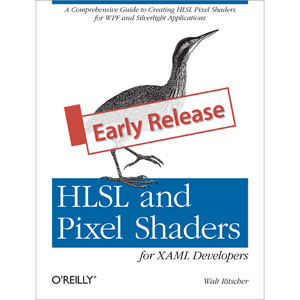Wow! eBook: Node: Up and Running - 5 new eBooks |  |
- Node: Up and Running
- Learning JavaScript Design Patterns
- Developing Backbone.js Applications
- Getting Started with Metro Apps
- HLSL and Pixel Shaders for XAML Developers
| Posted: 17 May 2012 10:57 AM PDT
Book DescriptionThis book introduces you to Node, the new web development framework written in JavaScript. You’ll learn hands-on how Node makes life easier for experienced JavaScript developers: not only can you work on the front end and back end in the same language, you’ll also have more flexibility in choosing how to divide application logic between client and server. Written by a core contributor to the framework, Node: Up and Running shows you how Node scales up to support large numbers of simultaneous connections across multiple servers, and scales down to let you create quick one-off applications with minimal infrastructure. Built on the V8 JavaScript engine that runs Google Chrome, Node is already winning the hearts and minds of many companies, including Google and Yahoo! This book shows you why.
Table of Contents Book Details
Related Posts
|
| Learning JavaScript Design Patterns Posted: 17 May 2012 10:53 AM PDT
Book DescriptionWith this digital Early Release edition of Learning JavaScript Design Patterns, you get the entire book bundle in its earliest form – the author’s raw and unedited content – so you can take advantage of this content long before the book’s official release. You’ll also receive updates when significant changes are made, as well as the final ebook version. If you want to write beautiful, structured, and maintainable JavaScript code, this guide shows you how to apply both classical and modern design patterns to the language. The patterns in this book provide reusable code solutions to common problems in software design, and give you a shared vocabulary for describing solutions to others. You’ll explore several popular design patterns in plain JavaScript as well as jQuery and other abstracted libraries. If you're familiar with concepts such as closures and prototypal inheritance, you'll be able to determine why some patterns may be more suitable for your projects than others.
Table of Contents Book Details
Related Posts
|
| Developing Backbone.js Applications Posted: 17 May 2012 10:47 AM PDT
Book DescriptionWith this digital Early Release edition of Developing Backbone.js Applications, you get the entire book bundle in its earliest form – the author’s raw and unedited content – so you can take advantage of this content long before the book’s official release. You’ll also receive updates when significant changes are made, as well as the final ebook version. Get a complete run-down of the popular Backbone.js framework for structuring JavaScript applications. This practical guide takes you through Model–view–controller (MVC) theory, and shows you how to build applications using Backbone’s models, views, collections and routers. You'll also learn advanced topics such as modular development with Backbone.js and RequireJS. This detailed book provides an authoritative and centralized repository of information to help you develop real-world apps with Backbone.
Table of Contents Book Details
Related Posts
|
| Getting Started with Metro Apps Posted: 17 May 2012 10:43 AM PDT
Book DescriptionWith this digital Early Release edition of Getting Started with Metro Apps, you get the entire book bundle in its earliest form – the author’s raw and unedited content – so you can take advantage of this content long before the book’s official release. You’ll also receive updates when significant changes are made, as well as the final ebook version. Get a head start on creating “Metro”-style apps for the approaching release of Windows 8. If you're new to .NET programming, this introductory guide will quickly get you up to speed on the tools you need to build user interfaces with Microsoft's new design language, code-named Metro. Learn how to use WinRT and the preview version of the upcoming Visual Studio release, and get tips and tricks for having your app published in the Windows Store. Windows 8 brings some dramatic changes to the way users interact with computers and devices, and the Metro design language plays a key role. Whether you're an experienced .NET developer, or build apps with HTML and Javascript, this book gets you in on the ground floor. Table of Contents
Book Details
Related Posts
|
| HLSL and Pixel Shaders for XAML Developers Posted: 17 May 2012 10:38 AM PDT
Book DescriptionWith this digital Early Release edition of HLSL and Pixel Shaders for XAML Developers, you get the entire book bundle in its earliest form – the author’s raw and unedited content – so you can take advantage of this content long before the book’s official release. You’ll also receive updates when significant changes are made, as well as the final ebook version. Graphic Shaders are used throughout the game and movie industry to improve onscreen graphics. They are versatile, doing important tasks like making computer rendered aliens look realistic, providing the ripples on a background lake or growing fur on the latest Pixar monster. In the PC world, programmers are often delighted to find that shaders are nothing more than a miniature program that is optimized to run on the computers GPU. This happiness fades when they start exploring the strange programming model underlying shaders however. Because shaders are strung together in an unusual fashion and run on a massive parallel processer developers shouldn't use their traditional OO or procedural approach to writing code. Writing effective shaders requires a mind shift regarding how to craft a useful algorithm. To top it off, shaders are written in a unfamiliar C-like language. In the Microsoft DirectX world the dominant language is High Level Shader Language or HLSL. Table of Contents Book Details
Related Posts
|
| You are subscribed to email updates from Wow! eBook - Blog To stop receiving these emails, you may unsubscribe now. | Email delivery powered by Google |
| Google Inc., 20 West Kinzie, Chicago IL USA 60610 | |






Tidak ada komentar:
Posting Komentar